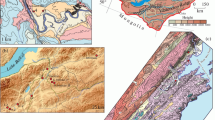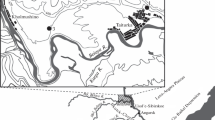Abstract
Carbonate pedofeatures of three chernozemic soils developed from loesslike loams in the foreststeppe zone of Lipetsk oblast under fallow plot (Luvic Chernozem (Clayic, Pachic)) and under forest (Calcic Chernozem (Clayic, Pachic)) and in the steppe zone of Dnepropetrovsk oblast (Calcic Chernozem (Episiltic, Endoclayic, Pachic)) were studied in the field and laboratory with the use of a set of methods, including the radiocarbon method, mass spectrometry, and micro- and submicromorphology. The morphological diversity of carbonate pedofeatures in these soils was represented by carbonate veins, coatings, disperse carbonates (carbonate impregnations), soft masses (beloglazka), and concretions. In the forest-steppe soils, disperse carbonates and soft masses were absent. The radiocarbon age of carbonate pedofeatures in the forest-steppe soils varied within a relatively narrow range of 3–4.3 ka cal BP with a tendency for a younger age of carbonate concretions subjected to destruction (geodes). In the steppe chernozem, this range was larger, and the 14C ages of different forms of carbonate pedofeatures were different. Thus, soft masses (beloglazka) had the age of 5.5–6 ka cal BP; disperse carbonates, 17.5–18.5 ka cal BP; and hard carbonate concretions, 26–27 ka cal BP. Data on δ13C demonstrated that the isotopic composition of carbon in virtually all the “nonlabile” carbonate pedofeatures does not correspond to the isotopic composition of carbon of the modern soil organic matter. It was shown that the studied chernozemic soils are polygenetic formations containing carbonate pedofeatures of different ages: (a) recent (currently growing), (b) relict, and (c) inherited pedofeatures. The latter group represents complex pedofeatures that include ancient fragments integrated in younger pedofeatures, e.g., the Holocene soft carbonate nodules with inclusions of fragments of the ancient microcodium.
Similar content being viewed by others
References
V. M. Alifanov, L. A. Gugalinskaya, and Yu. A. Ovchinnikov, Paleocryogenesis and Diversity of Soils in the Center of East European Plain (GEOS, Moscow, 2010) [in Russian].
E. V. Arinushkina, Manual on the Chemical Analysis of Soils (Moscow State Univ., Moscow, 1970) [in Russian].
G. S. Bazykina and S. V. Ovechkin, “Migration-mycelial chernozems of Kursk oblast in climatic and biosphere cycles,” Byull. Pochv. Inst. im. V.V. Dokuchaeva, No. 70, 3–17 (2012).
N. A. Belova and A. P. Travleev, Natural Forests and Steppe Soils: Ecology, Micromorphology, and Genesis (Dnepropetrovsk State Univ., Dnepropetrovsk, 1999) [in Russian].
V. V. Dobrovol’skii, “Carbonate concentrations in soils and parent materials of the central chernozemic region,” Pochvovedenie, No. 5, 31–42 (1956).
L. L. Shishov, V. D. Tonkonogov, I. I. Lebedeva, and M. I. Gerasimova, Classification and Diagnostic System of Russian Soils (Oikumena, Smolensk, 2004) [in Russian].
I. I. Lebedeva, “Humus and carbonate accumulations as diagnostic criteria in chernozems of Eastern Europe,” Byull. Pochv. Inst. im. V.V. Dokuchaeva, No. 68, 3–18 (2011).
I. I. Lebedeva and S. V. Ovechkin, “Carbonate profile of East European chernozems,” in Soil Science: Aspects, Problems, and Solutions (Dokuchaev Soil Science Inst., Moscow, 2003), pp. 56–83.
A. V. Makedonov, Modern Concretions in Sediments and Soils and Their Geographical Distribution (Nauka, Moscow, 1966) [in Russian].
V. I. Nikolaev, P. Yakumin, A. L. Aleksandrovskii, et al., Human Environment in the Holocene According to the Isotope-Geochemical and Soil-Archeological Studies in European Russia (Institute of Geography, Russian Academy of Sciences, Moscow, 2002) [in Russian].
S. V. Ovechkin and G. S. Bazykina, “The carbonate profile and water regime of migrational-mycelial chernozems in different ecosystems of Kursk oblast,” Eurasian Soil Sci. 44 (12), 1352–1363 (2011).
T. V. Prokof’eva, T. I. Malysheva, and Yu. E. Alekseev, Zonal Practice in Soil Science. Route Description (Oikumena, Smolensk, 2005) [in Russian].
Guide of Scientific Excursions of the XII International Symposium and Open Seminar on Paleosoil Science “Paleosols, Pedosediments, and Relief as the Archives of Environmental Conditions,” Kursk and Voronezh Oblasts, Russia, August 10–15, 2013, Ed. by I. V. Kovda (Institute of Geography, Russian Academy of Sciences, Moscow, 2013) [in Russian].
E. V. Rubilin and M. G. Kozyreva, “Age of Russian chernozem,” Pochvovedenie, No. 7, 16–26 (1974).
Ya. G. Ryskov and V. A. Demkin, Development of Soils and the Environment in the Steppes of Southern Ural in the Holocene: Reconstruction Using Geochemistry of Stabile Isotopes (Pushchino Scientific Center, Russian Academy of Sciences, 1997) [in Russian].
A. N. Simakova, Candidate’s Dissertation in Geology-Mineralogy (Moscow, 2008).
S. A. Sycheva, “Cycles of soil formation and sediment accumulation in the Holocene (according to 14C data),” Eurasian Soil Sci. 325 (6), 613–623 (1999).
Theory and Practice of the Chemical Analysis of Soils, Ed. by L. A. Vorob’eva (GEOS, Moscow, 2006) [in Russian].
O. S. Khokhlova, Doctoral Dissertation in Geography (Moscow, 2008).
O. S. Khokhlova, A. V. Rusakov, A. M. Kuznetsova, T. N. Myakshina, and Yu. G. Chendev, “Radiocarbon dating of pedogenic carbonates in deep horizons of forest-steppe soils,” Pochvovedenie, No. 9, 1095–1109 (2013).
A. V. Shnitnikov, Centennial Variability of the Components of Total Moistening (Nauka, Leningrad, 1969) [in Russian].
T. E. Cerling, “The stable isotopic composition of modern soil carbonate and its relationships to climate,” Earth Planet. Sci. Lett. 71, 229–240 (1984).
T. E. Cerling, “Carbon dioxide in the atmosphere: evidence from Cenozoic and Mezozoic paleosols,” Am. J. Sci. 291, 377–400 (1991).
T. Cerling, J. Quade, Y. Wang, and J. R. Bowman, “Carbon isotopes in soils and paleosols as ecology and paleoecology indicators,” Nature 341, 138–139 (1989).
N. Durand, H. C. Monger, and M. G. Canti, “Calcium carbonate features,” in Interpretation of Micromorphological Features of Soils and Regoliths, Ed. by G. Stoops, V. Marcelino, and F. Mees (Elsevier, Amsterdam, 2010), pp. 157–202.
Polibino, Dankovsky district, Lipetsk oblast. http://en.wikipedia.org/wiki/Polibino,_Dankovsky_District,_Lipetsk_Oblast.
IUSS Working Group WRB, World Reference Base for Soil Resources 2014. International Soil Classification System for Naming Soils and Creating Legends for Soil Maps, World Soil Resour. Rep. No. 106 (Food and Agriculture Organization, Rome, 2014).
I. Kovda, E. Morgun, and K. Gongalsky, “Stable isotopic composition of carbonate pedofeatures in soils across the transect, south of the European part of Russia,” Catena 112, 56–64 (2014). http://dx.doi.org/. doi 10.1016/j.catena.2013.01.005
I. Kovda, S. Sycheva, M. Lebedeva, and S. Inozemtzev, “Variability of carbonate pedofeatures in a loess-paleosoil sequence and their use for paleoreconstructions,” J. Mountain Sci. 6 (2), 155–161 (2009).
I. V. Kovda, L. P. Wilding, and L. R. Drees, “Micromorphology, submicroscopy, and microprobe study of carbonate pedofeatures in a vertisol gilgai soil complex, South Russia,” Catena 54, 457–476 (2003).
I. P. Montañez, “Modern soils system constraints on reconstructing deep-time atmospheric CO2,” Geochim. Cosmochim. Acta 101, 57–75 (2013). doi 10.1016/j.gca.2012.10.012
V. V. Skripkin and N. N. Kovalukh, “Recent developments in the procedures used at the SSCER laboratory for the routine preparation of lithium carbide,” Radiocarbon 40, 211–214 (1998).
J. Quade, T. Cerling, and J. Bowman, “Systematic variations in the carbon and oxygen isotopic composition of pedogenic carbonate along elevation transects in the southern Great Basin, United States,” Geol. Soc. Am. Bull. 101, 464–475 (1989).
Author information
Authors and Affiliations
Corresponding author
Additional information
Original Russian Text © I.V. Kovda, E.G. Morgun, M.P. Lebedeva, S.A. Oleinik, V.A. Shishkov, 2016, published in Pochvovedenie, 2016, No. 7, pp. 874–891.
Rights and permissions
About this article
Cite this article
Kovda, I.V., Morgun, E.G., Lebedeva, M.P. et al. Identification of carbonate pedofeatures of different ages in modern chernozems. Eurasian Soil Sc. 49, 807–823 (2016). https://doi.org/10.1134/S106422931607005X
Received:
Published:
Issue Date:
DOI: https://doi.org/10.1134/S106422931607005X




